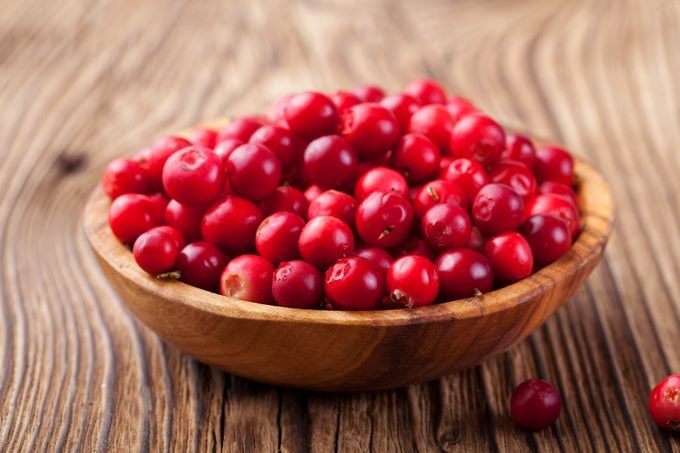Can Dogs Eat Cranberries? 13 Things to Know
Updated: Mar. 16, 2022
Cranberries are loaded with nutrients. But can dogs eat cranberries? Here's what veterinarians say.
An underrated berry
Cranberries may not be as popular as sweeter types like strawberries, blueberries, raspberries, and blackberries. But despite their bitter taste, cranberries are a healthy source of a range of nutrients.
Cranberry health benefits include everything from heart health to immune boosting. If you’re a fan of the tart fruit, you might be tempted to toss a few to your four-legged friend. But can dogs eat cranberries?
Humans and canines can’t eat all the same foods. So we asked the experts if it’s a good idea to share this holiday favorite with Fido.
Here’s the answer to whether dogs can eat cranberries or cranberry-related products like juice and the dried fruit.
Why are some foods dangerous for dogs?
There are a lot of different reasons dogs need to avoid certain human foods.
Some foods may be choking hazards for dogs. Others contain parts that can cause a dog to choke. Sharp or prickly foods may also damage tissues in the mouth, throat, and other parts of the digestive tract.
And then there are foods that actually toxic to dogs—the foods contain substances that harm healthy canine cells.
Can dogs eat cranberries?
“Dogs can eat berries, and they can be healthy for them in moderation, although not all dogs like to eat them,” says Jerry Klein, DVM, the chief veterinary officer of the American Kennel Club (AKC). “Cranberries tend to be bitter, and generally dogs don’t like their bitter taste.”
Because they’re not toxic, there’s no specific “safe” amount of cranberries to give a dog. But according to the experts, treats like cranberries should generally only account for between 5 and 10 percent of a dog’s daily calorie intake.
Tina Wismer, DVM, the senior director of the American Society for the Prevention of Cruelty to Animals (ASPCA) Animal Poison Control Center, says your pet should get most of its nutrition from its regular diet, so keep treat portion sizes small.
How many cranberries can dogs eat?
As with any food, the amount of a treat you give to a dog should depend on the dog’s size. This means smaller dogs should eat smaller portions than larger dogs.
The AKC cautions pet owners not to feed dogs too many cranberries, regardless of the dog’s size, how accustomed it is to cranberries, or how much it likes them.
Eating many cranberries can cause dogs to develop bladder stones, abnormal deposits made of calcium oxalate. If these stones become large, they can interfere with urine flow and irritate internal tissues.
Very large bladder stones can get stuck in or pass through the ureters, the tubelike organs that allow urine to flow out of the body. This can cause pain, vomiting, and unexplained tiredness or lack of energy.

Is there any reason to feed dogs cranberries?
Cranberries, like most berries, are rich in vitamins, minerals, other nutrients, and antioxidants, which help prevent cellular damage that occurs during most bodily processes. Antioxidants also help prevent cellular damage caused by exposure to substances found in smoke, sunlight, and pollution.
Some of the most abundant nutrients in cranberries are:
Fiber
Cranberries are a great source of fiber. Fiber is plant roughage that is hard (or impossible) to digest, and it helps a dog feel full longer after eating.
Fiber also helps regulate blood sugar levels. Eating a lot of fiber is linked to a lower risk of type 2 diabetes and other metabolic conditions.
Potassium
Potassium is vital for healthy cell functioning in nearly every part of the body. Not getting enough potassium can lead to the development of kidney stones, increased blood pressure, and reduced calcium levels in the bones.
Vitamin A
Vitamin A is important for healthy immune function, vision, and reproductive health. It is also crucial to the proper functioning of many organs, such as the heart, kidneys, and lungs.
Vitamin E
Cells use vitamin E to help them interact. Vitamin E is also important to immune health and helps widen blood vessels, reducing blood pressure, and prevents blood clots.
Vitamin C
Vitamin C is important for immune health, wound healing, and skin health.
Vitamin K
Vitamin K is important for bone health and helps blood form clots that can prevent excessive bleeding.
Vitamin B5
Vitamin B5, also known as pantothenic acid, helps convert foods and drinks we consume into energy that cells can use. Vitamin B5 is particularly important for the digestion of fats.
Vitamin B6
Vitamin B6 is important for immune health. But more important, vitamin B6 plays a role in more than 100 different interactions involved in the breakdown and digestion of foods and drinks. Vitamin B6 also helps babies’ brains develop properly during pregnancy and infancy.
Can dogs have cranberry juice?
In short, no, dogs should not consume cranberry juice.
While there’s nothing toxic or very dangerous about feeding dogs cranberry juice, there can be negative health effects and little to no nutritional benefit.
“The nice thing about berries is that they’re filled with fiber and other nutrients,” says Barbara Hodges, DVM, the director of advocacy and outreach for the Humane Society Veterinary Medical Association. “But when you juice something, you get rid of the fiber and only end up with the liquid of the fruit.”
What results is a product very high in fruit sugars and low in nutrients, unless the manufacturer adds vitamins and minerals back into the juice after processing.
Because of cranberries’ bitter taste, cranberry juice is also often mixed with other fruit juices. Grape juice in particular is a frequent addition—and it’s toxic to dogs.
“I would steer away from feeding your pets fruit juices,” Dr. Hodges concludes.
Can dogs eat dried cranberries?
Veterinarians say dried cranberries are not a good treat for dogs because they often have sugar added to them. A lot of nutrition found in cranberries also tends to be lost during processing.
Dr. Hodges says most products also do not indicate how the cranberries were dried or if any chemicals or other additives were present during the manufacturing process.
Dried berries—especially cranberries, she adds—also tend to come in mixes with other dried fruits and nuts, some of which may not be safe for dogs. Those include raisins, currants, and some types of nuts.
Can dogs eat cranberry sauce or canned cranberries?
Don’t feed dogs fruit that has been sugared or packed in syrup, as canned cranberries often are. Dr. Klein says this adds even more sugar and calories and defeats the purpose of feeding your pup a “healthy” treat.
“Too much sugar is not good for dogs, especially if a dog has an underlying medical issue, such as diabetes,” he says.
Dr. Hodges says to only offer cranberry sauce to a dog if you are sure exactly what is in it. You don’t want to accidentally feed your dog cranberry sauce that contains toxic ingredients.
Some of these products may contain types of alcohol or alcohol-like substances, she says, which can harm dogs. and cranberry sauce recipes may also include foods toxic to dogs, like grapes, raisins, and currents.
Your safest bet is to follow the experts’ advice and avoid feeding dogs cranberry sauces, canned cranberries, and cranberry preserves.
Can dogs eat wild cranberries and cranberry plant parts?
According to experts, wild cranberries are fine for dogs to eat. But it can be nearly impossible to know if wild berries have been sprayed with any chemicals or exposed to any other harmful substances. So always pick and wash wild berries before feeding them to a dog.
When it comes to cranberry plant parts like leaves and stems, veterinarians say you should avoid letting your dogs consume them.
“Dogs should not eat any plant parts other than the berries,” says Dr. Hodges. “Leaves, stems … they are virtually indigestible. Stems and other hard or sharp plant parts can also damage the GI [gastrointestinal] tract.”
Do dogs benefit from a varied diet like humans?
Veterinarians like Dr. Hodges advocate for feedings dogs a varied diet. She often asks her human clients to consider how they would feel about eating the same thing day in and day out their entire lives.
Aside from the obvious risk of boredom, feeding dogs the exact same food every day may also carry some minor health risks.
“I recommend rotating new foods and diets because no one diet is perfect. Every diet is likely to have some minor deficiencies in it, so if you keep rotating or changing their diet every few weeks or so, you are likely covering your nutritional bases,” she says.
If your dog has gotten less excited about mealtime, try introducing some new foods.
“Switching up foods can also make dogs look forward to or enjoy their meals or treats more,” says Dr. Hodges. “I like to tell people my dogs never know exactly what they’ll be getting for dinner.”
How to start feeding dogs cranberries
The experts say one of the most important things to remember about feeding a dog any new type of food is that you do not know how they will tolerate it.
Like people, dogs will have their own individual allergies and sensitives. And some dogs may simply dislike the taste of cranberries.
Dr. Klein says to monitor your pet as you gradually introduce a new food into its diet. It’s always best to start with a very small portion and only increase the portion if the dog is not having any negative reactions, such as major changes to their stool, nausea, vomiting, or skin reactions like itching or rashes.
Even if a dog isn’t necessarily sensitive or allergic to a new food, feeding it a lot of new food too soon is likely to cause digestive issues.
“Too much of a food your pet is not used to can lead to some digestive upset,” he says.
Preparing cranberries for dogs
When purchasing cranberries for your pooch, the most important thing is to buy only fresh or frozen cranberries. All other cranberry products tend to contain extra sugars, fats, lactose, alcohol, and other additives that a dog should not consume.
“If you buy a box of fresh berries, you know exactly what is in them,” says Dr. Hodges. “Packages of frozen berries also tend to tell you more about what’s in them.” She recommends buying organic or local when possible.
The experts say you should always generously wash and rinse fruits and vegetables before giving them to a dog. That’ll remove pesticides or other harmful chemical residues.
In most cases, cranberries are already a safe size for most pups to eat without any risk of choking or damaging their internal organs. Very small dogs, or dogs prone to choking, may need their cranberries sliced up or mushed before they eat them.
Xylitol, a dangerous add-in to avoid
Many food products come in varieties labeled “low-sugar” or “sugar-free,” such as yogurts, fruit juices, candies, and gum. But to be sugar-free or reduced in sugar, a lot of these products rely on artificial sweeteners, some of which can cause serious health problems for pets.
Of particular concern is the artificial sweetener xylitol. Eating too much xylitol causes digestive symptoms such as diarrhea in humans. But for dogs, xylitol can be deadly.
Dr. Wismer says always check the label of commercially prepared foods for this dangerous substance for dogs. “Xylitol can cause low blood sugar and liver failure in dogs,” she says.
Fruits, vegetables, and other foods dogs can’t eat
Wismer says it’s important to note that not all fruits and vegetables are safe for animals. “Be sure to avoid garlic, onions, raisins, and grapes, as they can be toxic to your pet,” she says.
According to the experts and authoritative animal organizations, here are some common foods that can be dangerous or toxic for dogs:
- mushrooms
- grapes and raisins
- asparagus
- onions, chives, and leeks
- garlic
- chocolate
- caffeine
- avocado
- cooking oils or butter
- most seasonings and salt
- cherries
- tomatoes
- candy
- gum
- alcohol
- hops
- macadamia nuts, walnuts, and almonds
- yeast dough
- potatoes
- plant and fruit seeds, pits, cores, skins, leaves, and stems
- citrus fruits
Next, find out if your dog can eat strawberries.




















